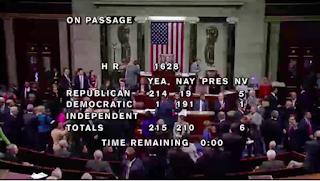By: Brandon M. Macsata, CEO, ADAP Advocacy Association
The executive budget — which is mandated by federal law to be submitted by the President of the United States to Congress — is rarely taken seriously because the legislative branch typically adopts a federal budget that does not come close to resembling the budget proposed by the executive branch. That said, it does signal the President's priorities for the coming year. Sadly, President Donald J. Trump's proposed budget makes clear that people living with HIV/AIDS (among many other chronic health conditions) aren't among his priorities.
The ADAP Advocacy Association was quick to condemn Trump's proposed budget via Twitter @adapadvocacy.
There is an emerging pattern with Trump, which started during the presidential primary and continued throughout the general election...and now into his presidency. He routinely makes statements that completely contradict one another, and his proposed budget continued that trend.
How?
Trump's budget for the U.S. Department of Health & Human Services ("HHS") included legislative language relevant to the reauthorization of the Ryan White CARE Act, which is technically due for an update. The language reads:
"The Administration looks forward to working with Congress to reauthorize the Ryan White program to ensure that Federal funds are allocated to address the changing landscape of HIV across the United States. Reauthorization of the Ryan White program should include changes to the funding methodologies for Parts A and B to ensure that funds may be allocated to target populations experiencing high or increasing levels of HIV infections/diagnoses, such as minority populations, while continuing to support Americans that are already living with HIV across the nation. African Americans, for example, account for a higher proportion of new HIV diagnoses, those living with HIV, and those ever diagnosed with AIDS as compared to other races/ethnicities. The new Ryan White authorization should allow for resources to be focused on populations with disproportionately high rates of new infections/diagnoses."Yet, that same budget called for draconian funding cuts to numerous federal programs specifically designed to assist people living with HIV/AIDS (including some authorized under the very same Ryan White). Among them:
- Eliminating $34 million for AIDS Education and Training Centers
- Eliminating $25 million for Special Projects of National Significance
- Reducing $13 million in funding for Rural Outreach Grants (19.05% decrease)
- Eliminating $42 million for Rural Hospital Flexibility Grants
- Reducing $7 million in funding for Telehealth (41.18% decrease)
- Reducing $9 million in funding for State Offices of Rural Health (90% decrease)
- Reducing $186 million in funding for HIV/AIDS, Viral Hepatitis, STIs and TB Prevention (16.61% decrease)
- Reducing $1.3 billion in funding for Social Services Block Grant (78.69% decrease)
Trump's budget has been universally denounced by the HIV/AIDS and Viral Hepatitis communities, as noted herein:
- Ken Bargar, Co-Chair, Florida HIV/AIDS Advocacy Network (FHAAN): "Somewhere the President's advisors failed him. These are budget cuts to peoples' lives, their medications, their care and their shelter. As advocates, we cannot allow this budget to get any traction or legitimize it in any way. Congress appropriates our country's spending and that's were we should put our efforts. Let's let every Member of Congress know we won't stand for an administration that is willing to kill it's own people."
- Michael Ruppal, Executive Director of The AIDS Institute: "The country has made great progress in the fight against HIV/AIDS and STDs, but if these cuts are enacted, we will turn back the clock, resulting in more new infections, fewer patients receiving care, and ultimately, more suffering from diseases that are preventable and treatable."
- William E. Arnold, President & CEO of the Community Access National Network: "The president’s budget fails to meet the rising tide of viral hepatitis at a time when we’re on the cusp of seeing a sharp rise in new Hepatitis C infections. Flat funding HCV programs, while also cutting key HIV-related programs will prove problematic as we attempt to address the growing number of individuals co-infected with both HIV, and HCV."
- Jesse Milan, Jr., President & CEO of AIDS United: "We have seen historic decreases in the number of new HIV infections over the past six years because of sustained investments in prevention, and we have thousands of HIV positive Americans who have yet to achieve viral suppression through treatment programs. By cutting funding, the work we have done will be reversed, and all the work left to do will falter and put the health of our nation at risk."
- Ryan Clary, Executive Director of the National Viral Hepatitis Roundtable (NVHR): "President Trump’s assault on the health care system through his unconscionable cuts to Medicaid and other vital safety net programs will cause severe harm to people living with and at risk for hepatitis B and C. If enacted, the result will be continued alarming increases in hepatitis B and C infections, high numbers of individuals unaware of their status, and needless death and suffering due to lack of access to care and treatment. NVHR calls on Congress to reject this budget immediately and work together to pass an appropriations bill that expands access to quality health care for all and increases badly needed funding for the Division of Viral Hepatitis at CDC."
- Murray C. Penner, Executive Director of the National Alliance of State & Territorial AIDS Directors (NASTAD): "Together we will fight these cuts at every stage of the appropriations process. We need to protect these programs that provide life-saving treatment for those living with HIV and work to prevent the spread of HIV and STDs. We trust that Congress will agree and recognize that these cuts are harmful, short-sighted, and will damage our nation's public health infrastructure."
- Edward Hamilton, Executive Director of the ADAP Educational Initiative: "The administration’s proposed budget cuts across multiple programs will set back the gains that have been made in domestic and worldwide HIV epidemics 20 years. With the proposed changes in Medicaid and the Affordable Care Act, ADAPs nationwide will collapse due to the unprecedented strains on their budgets from rising drug costs coupled with forecasted increased premiums."
 |
| Photo Source: GalleryHip.com |





